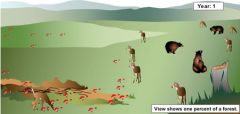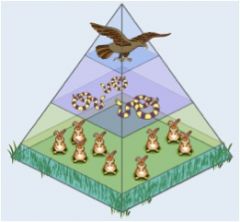![]()
![]()
![]()
Use LEFT and RIGHT arrow keys to navigate between flashcards;
Use UP and DOWN arrow keys to flip the card;
H to show hint;
A reads text to speech;
16 Cards in this Set
- Front
- Back
|
Plants that are able capture energy from the sun to produce food are called:
a- consumers b- carnivores c- producers d- heterotrophs |
C
|
|
|
A symbiotic relationship is formed:
(A) only when both organisms benefit from living closely together (B) when at least one organism benefits from living closely with another (C) when both organisms are related to each other |
B
|
|
|
A mutualistic relationship is one that:
(A) both organisms do not benefit (B) one organism benefits while the other is harmed (C) both organisms benefit |
C
|
|
|
Plants and algae can capture energy from sunlight through a process called __________________.
|
Photosynthesis
|
|

The following is an example of:
a- food chain b- food web |
Food chain
|
|

In the above illustration, the arrows indicate the transfer of _______________.
a- species b- food c- energy |
C- Energy
|
|
|
Which organism is a producer?
a- an oak tree b- a deer c- a mushroom d- a bear |
A- and oak tree
|
|

Below is a picture of a forest. What will happen in the next few years?
A. Deer, bears, and mushrooms will all increase in number. B. Deer, bears, and mushrooms will all decrease in number. C. Deer and bear populations will increase, but the mushroom population will decrease. D. Deer and mushroom populations will increase, but the bear populations will decrease. |
B-
|
|

In the food chain shown below, what do you think would happen if you were to double the rabbit population?
A. The populations of the grass, snakes, and hawks would also increase. B. The populations of the other species would decrease. C. The snake and hawk population would increase but the grass would decrease. D. The grass population and the hawk population would decrease. |
C
|
|
|
Part of an experiment where no change is made:
(A) control (B) variable (C) abiotic |
A
|
|
|
Any biotic or abiotic factor that influences population sizes is considered:
(A) reproductive potential (B) experiment (C) limiting factor |
C
|
|
|
It is important to change only one variable at a time during an experiment.
True False |
True
|
|
|
Algae is an example of a
(A) consumer (B) decomposer (C) producer |
c
|
|
|
Frogs are examples of
(A) consumers (B) producers (C) decomposers |
A
|
|
|
A symbiotic relationship is formed:
(A) only when both organisms benefit from living closely together (B) when at least one organism benefits from living closely with another (C) when both organisms are related to each other |
B
|
|
|
A mutualistic relationship is one that:
(A) both organisms do not benefit (B) one organism benefits while the other is harmed (C) both organisms benefit |
C
|

